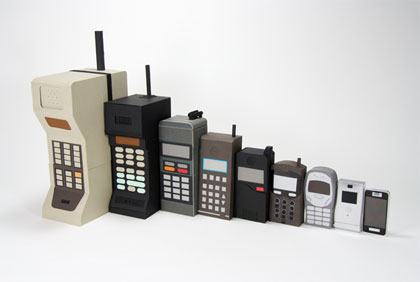History of Mobile Phones
-> Mobile phones started life as the two way radio, which was also called mobile rigs. These were installed in vehicles such as minicabs, police cars and ambulances, but were not strictly mobile phones as they were not normally connected to the telephone network. While the very first mobile phones were installed permanently in vehicles, later versions such as the transportable, also called bag phones, could also be carried, and can be used as either portable or as mobile two-way radios.

-> The first generation mobile phones are often called 1G. These mobile phones are the analog devices that were introduced in the eighties & continued until being replaced by 2G mobile phones, which ran on digital networks. In fact, even though 1G & 2G systems use digital signals to connect the radio towers to the rest of the telephone network, the voice itself during a phone call encoded to digital signals in 2G while voices on 1G phones aren't.
-> Second generation, also called 2G, mobile telephones were introduced in the nineties. 2G phone systems were characterized by their use of digital transmission and the introduction of advanced and fast phone to network signaling.
-> The birth of 2G systems saw telephones move from friendly 1G telephones to little handheld items, which were much more portable. This change was possible through technological developments including more advanced batteries and energy saving electronics.
-> The second generation mobile telephones had several advantages over 1G item. These included text messaging, which became possible on GSM networks initially and eventually on all digital networks. The earliest machine-sent message was sent in 1991 in the UK. The earliest person to person sms text message was sent in 1993 in Finland. sms text messaging soon became the preferred method of communication and the public now prefer sending text messages to placing voice calls.
-> 3G is the term applied to the third generation of mobile phone standards & technology. 3G follows 2G mobile phone technology.
-> The 3G technology allow network operators give their users a larger range of more advanced services. These include video calls& wireless internet.
-> Even though 3G was successfully introduced throughout the world, issues have been raised by both 3G providers & users, comprising of costly phones. In addition to this, there are numerous differences in the licensing terms.
-> Ever since the launch of 3G mobile phone technology, people have been talking about 4G. 4G technology will signify the future of mobile telephones, creating the most sophisticated handsets and best services yet. in actual fact, one of the next services to be developed is thought to be live streaming of radio and TV shows to 3G handsets is and shops including real and Disney recently announcing that they'll be offering services like these.
-> In conclusion, even though the history of mobile phones they have come a long way in the past few years, it also indicates that they'll go even further still.
Rate This Article:
Posted On: Friday, 12 October, 2012 - 15:43
